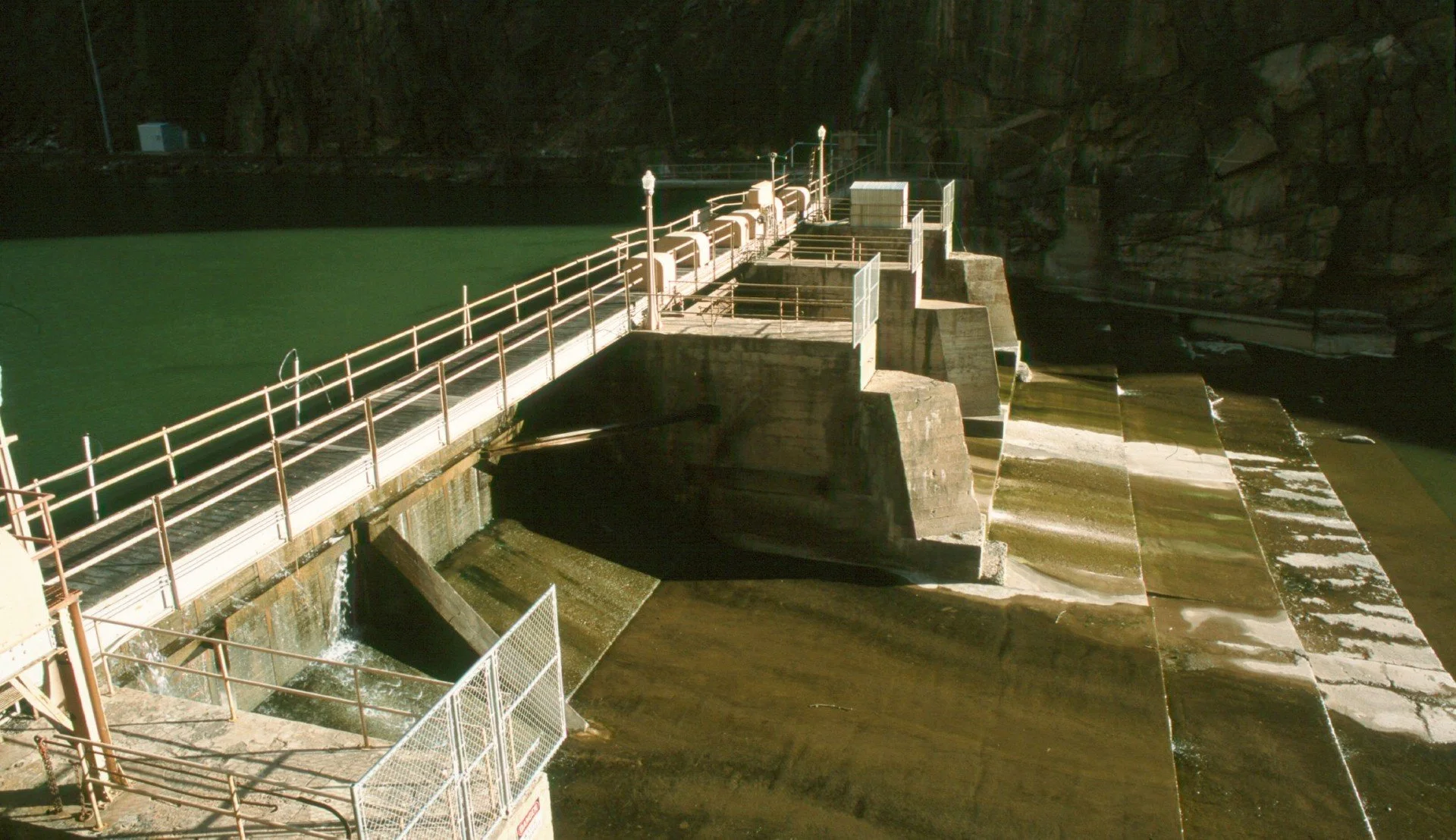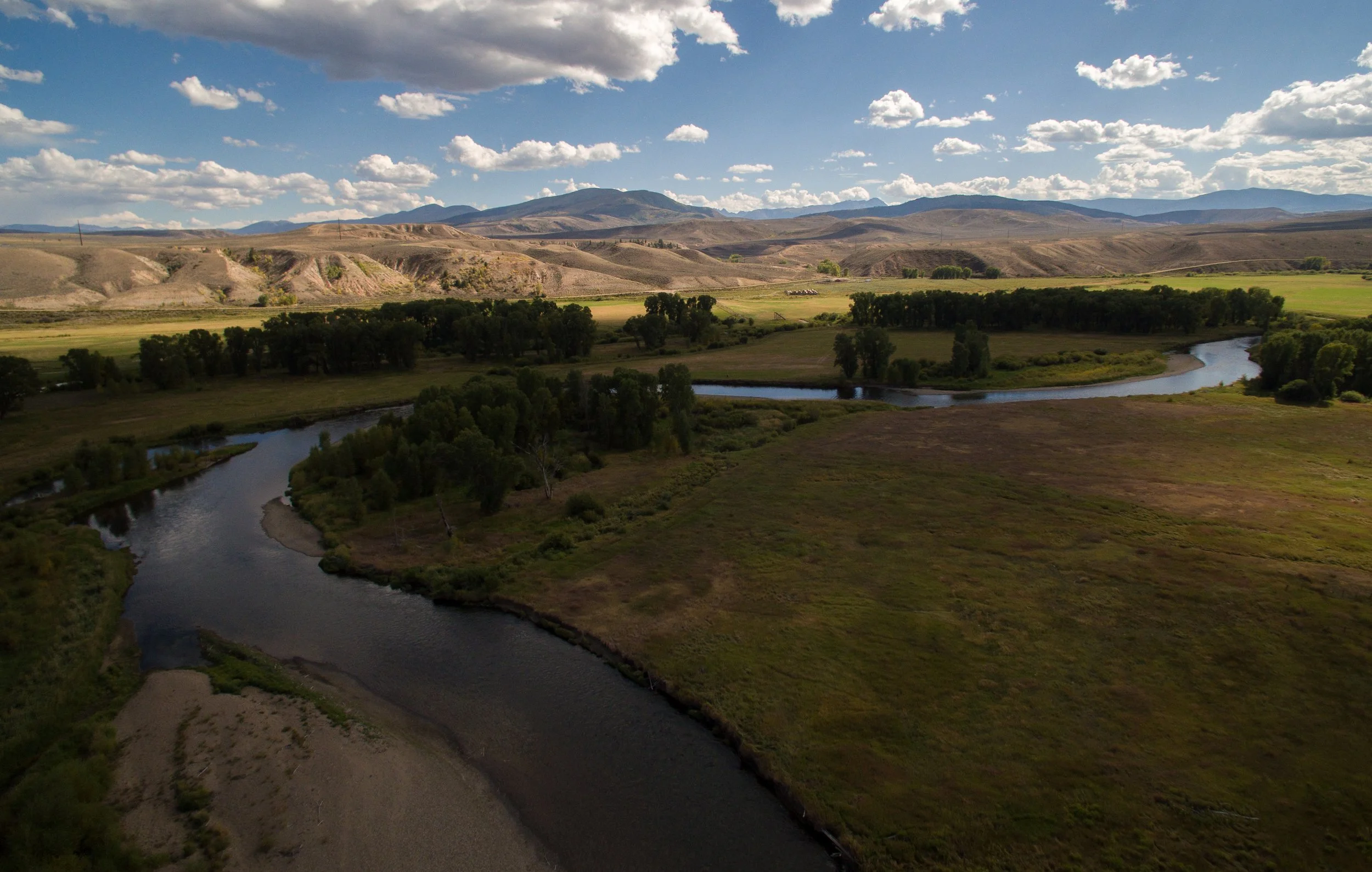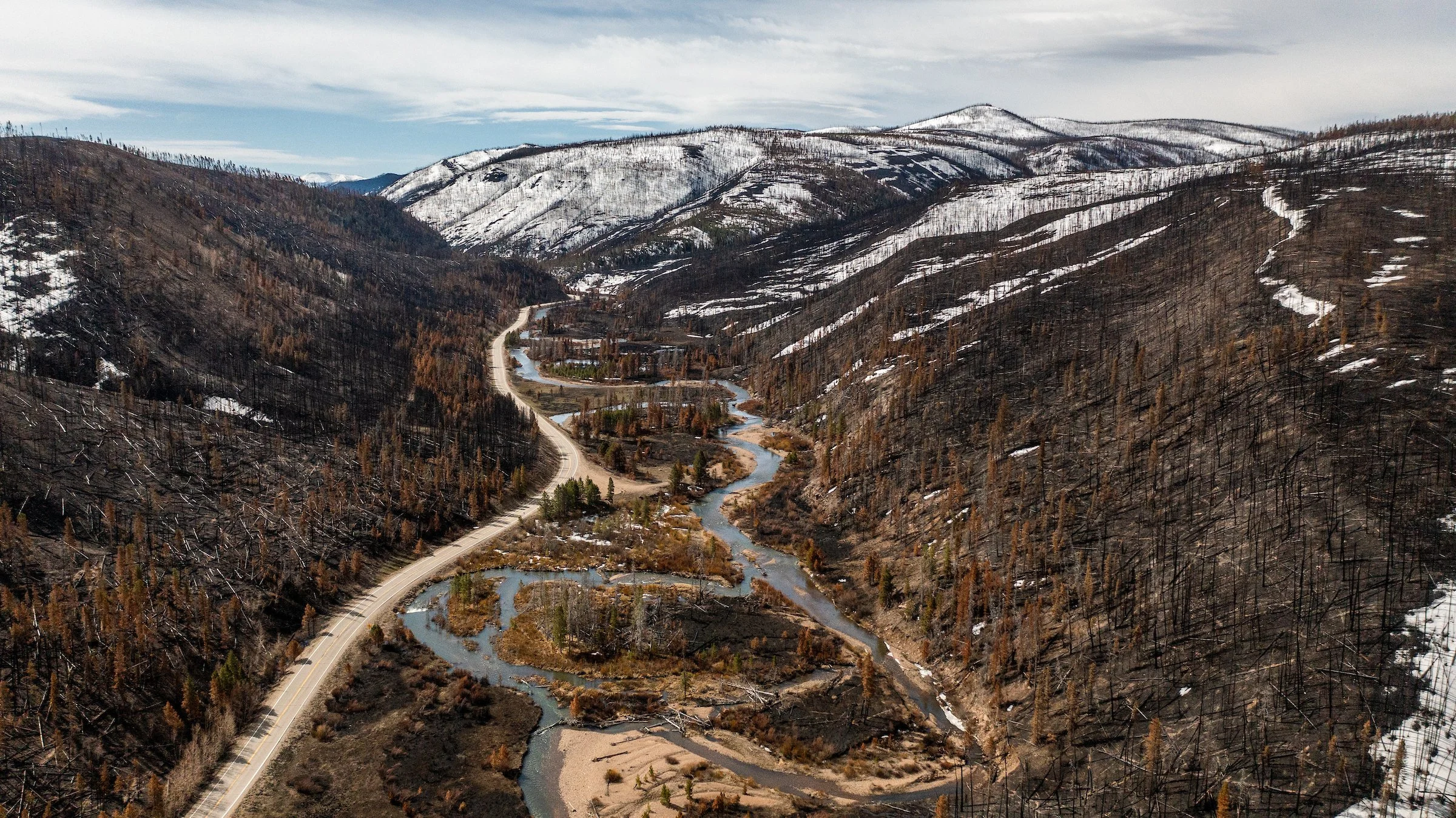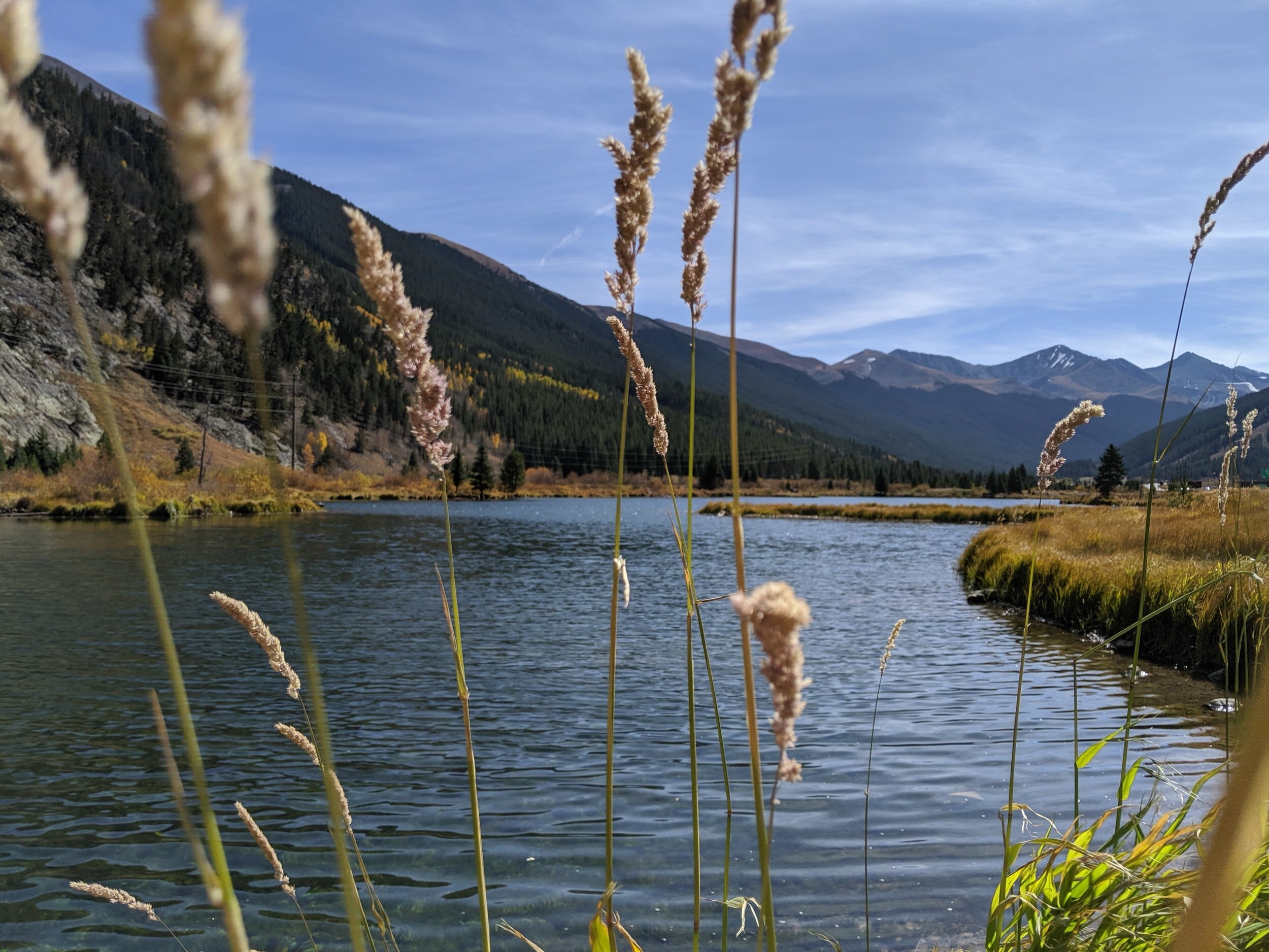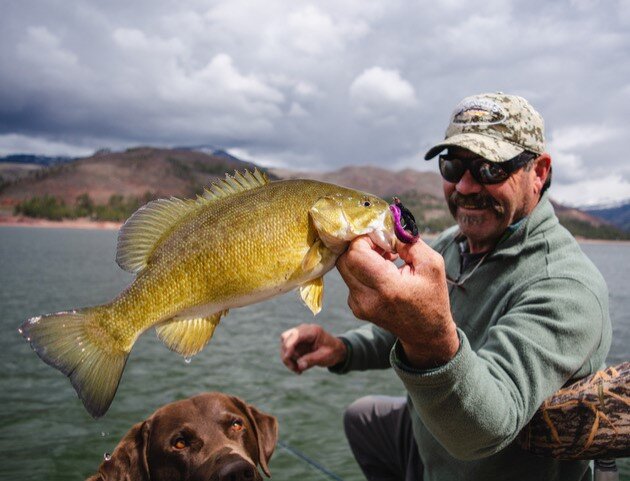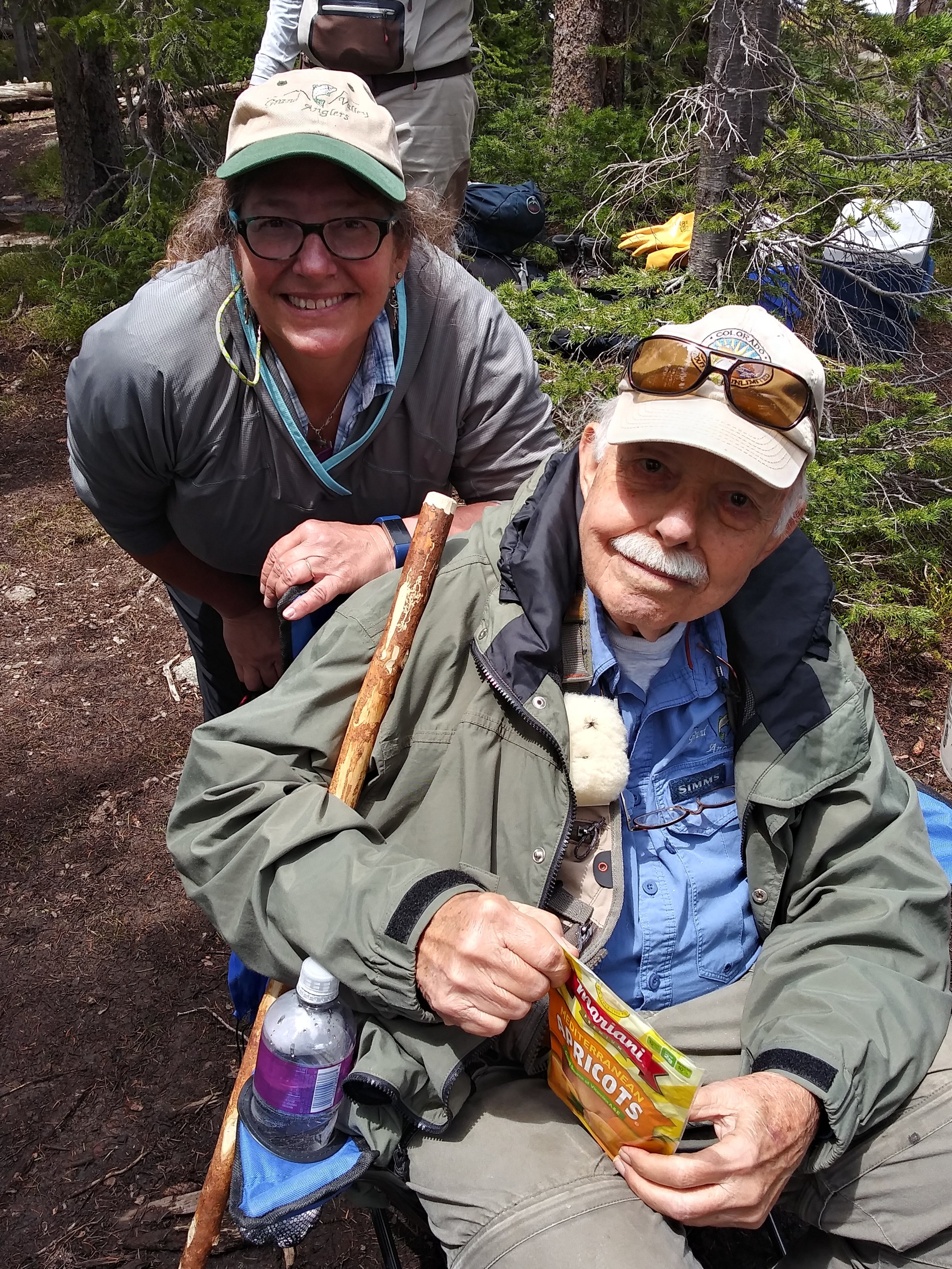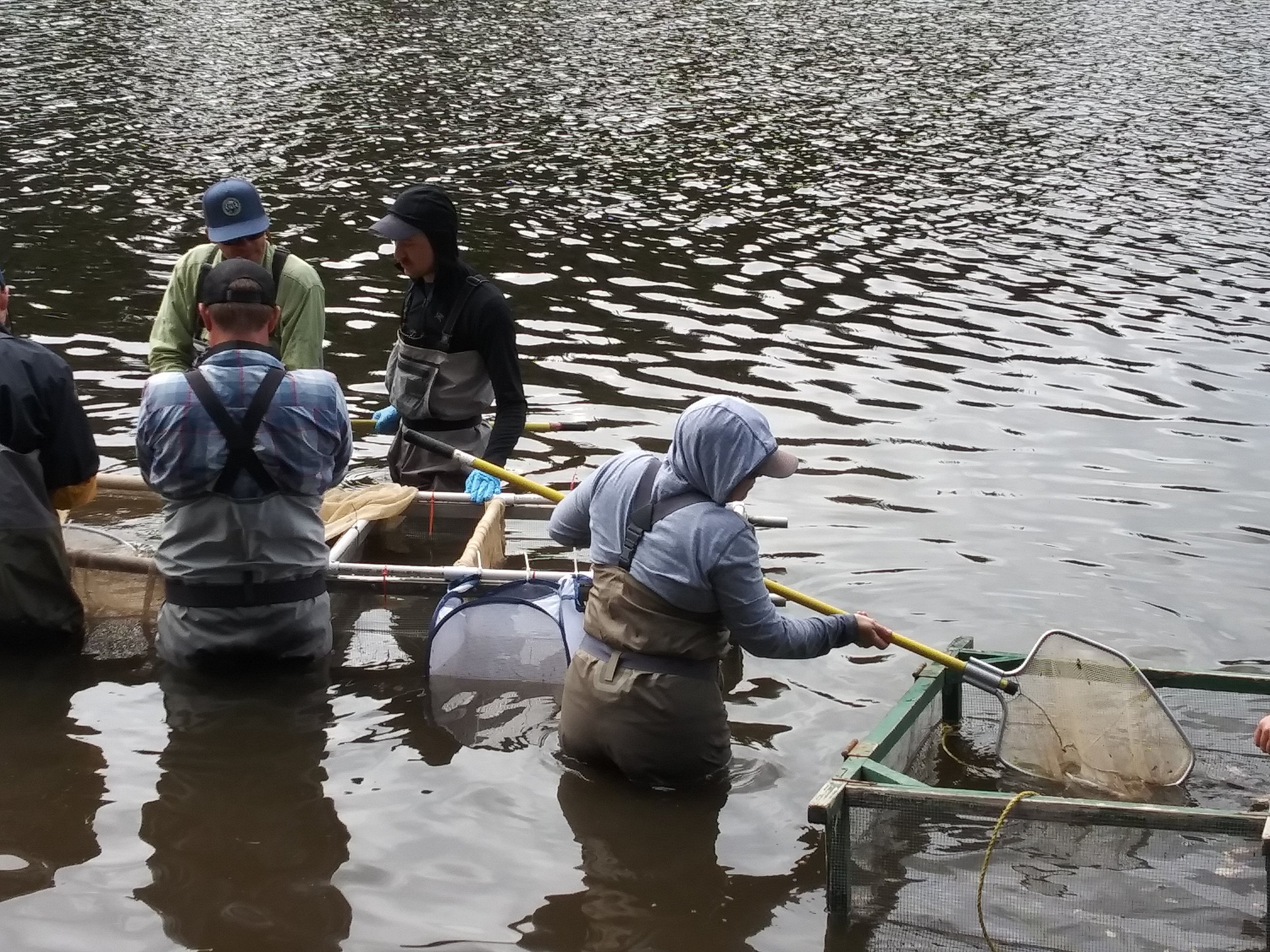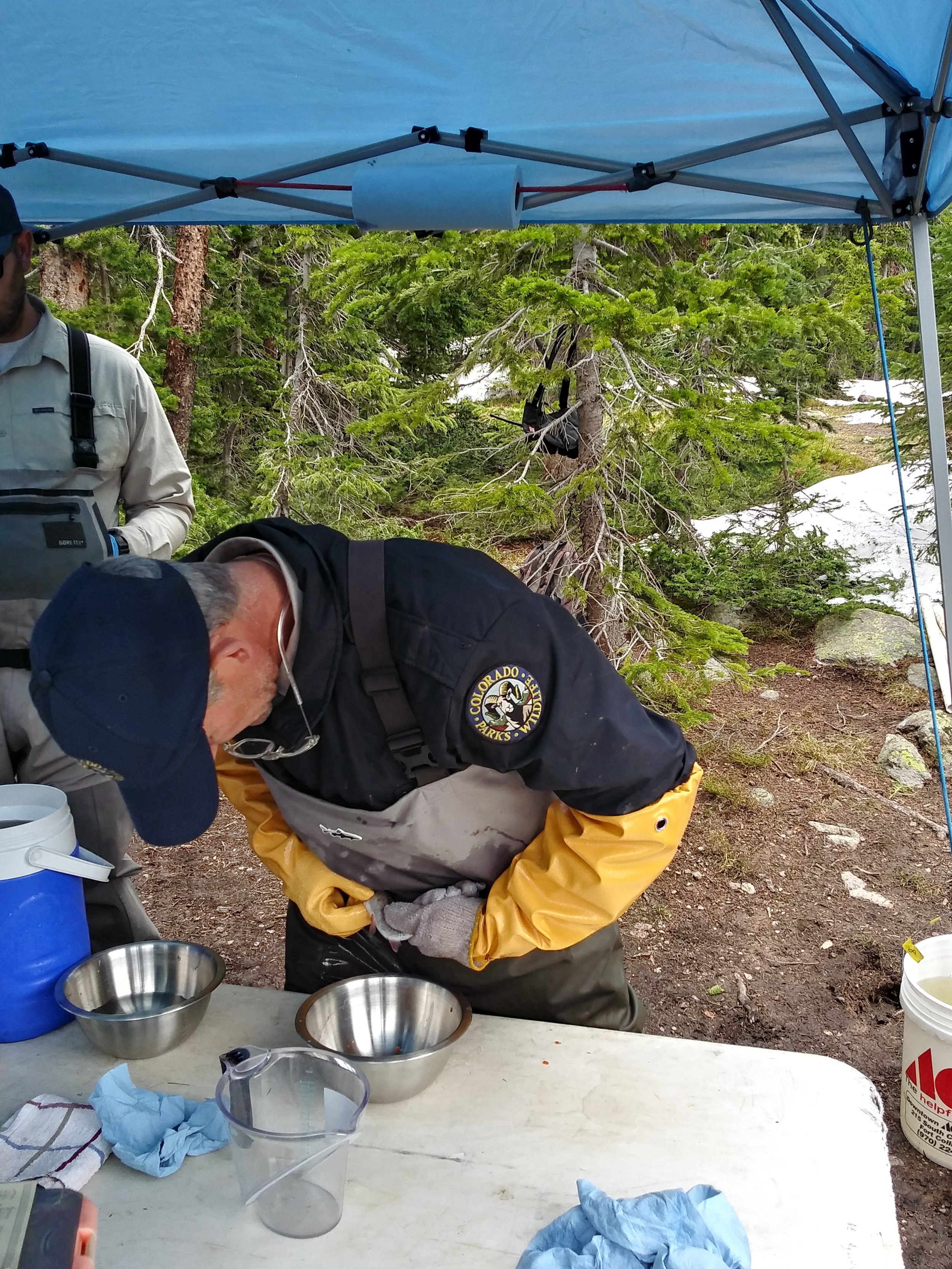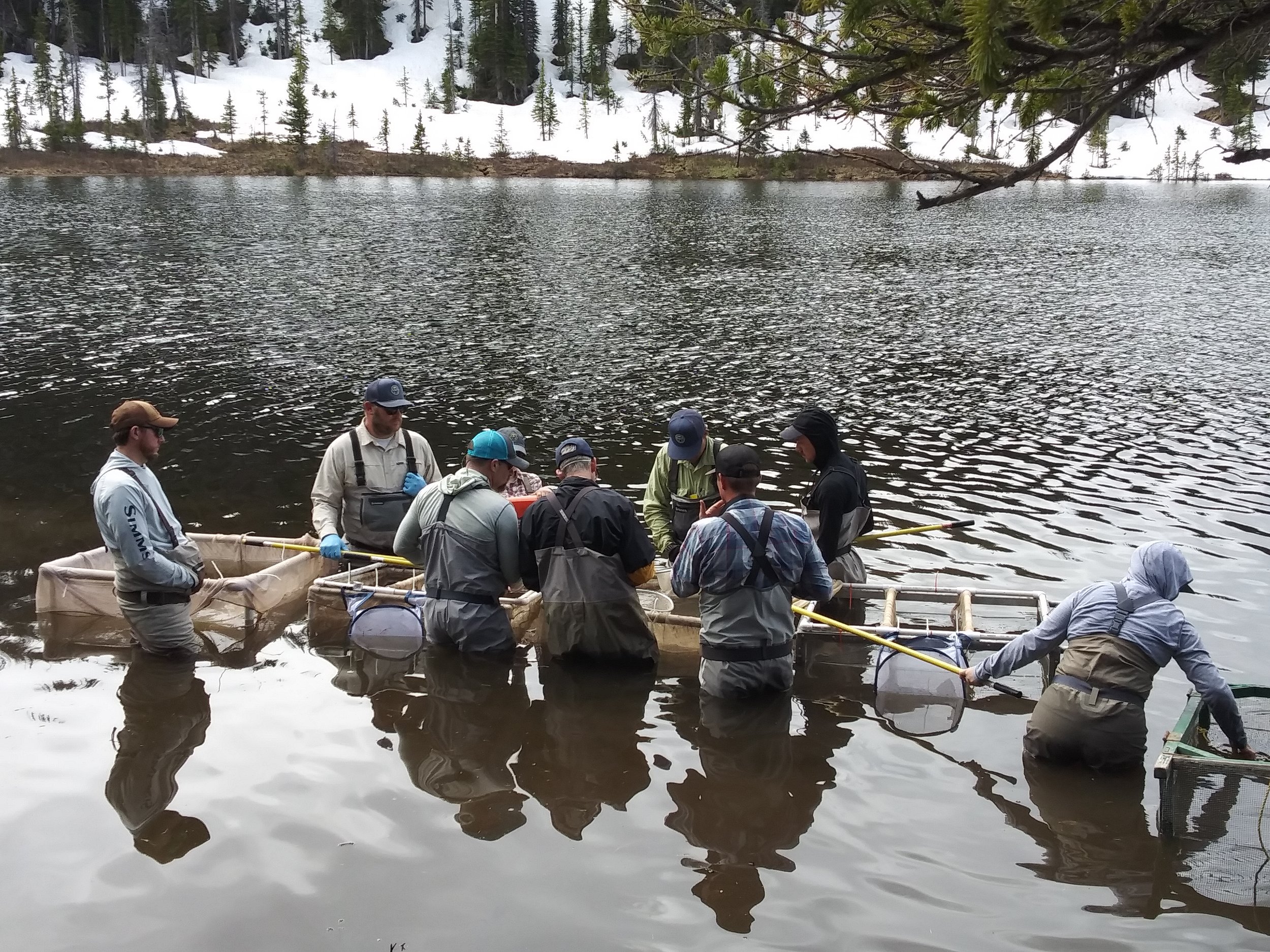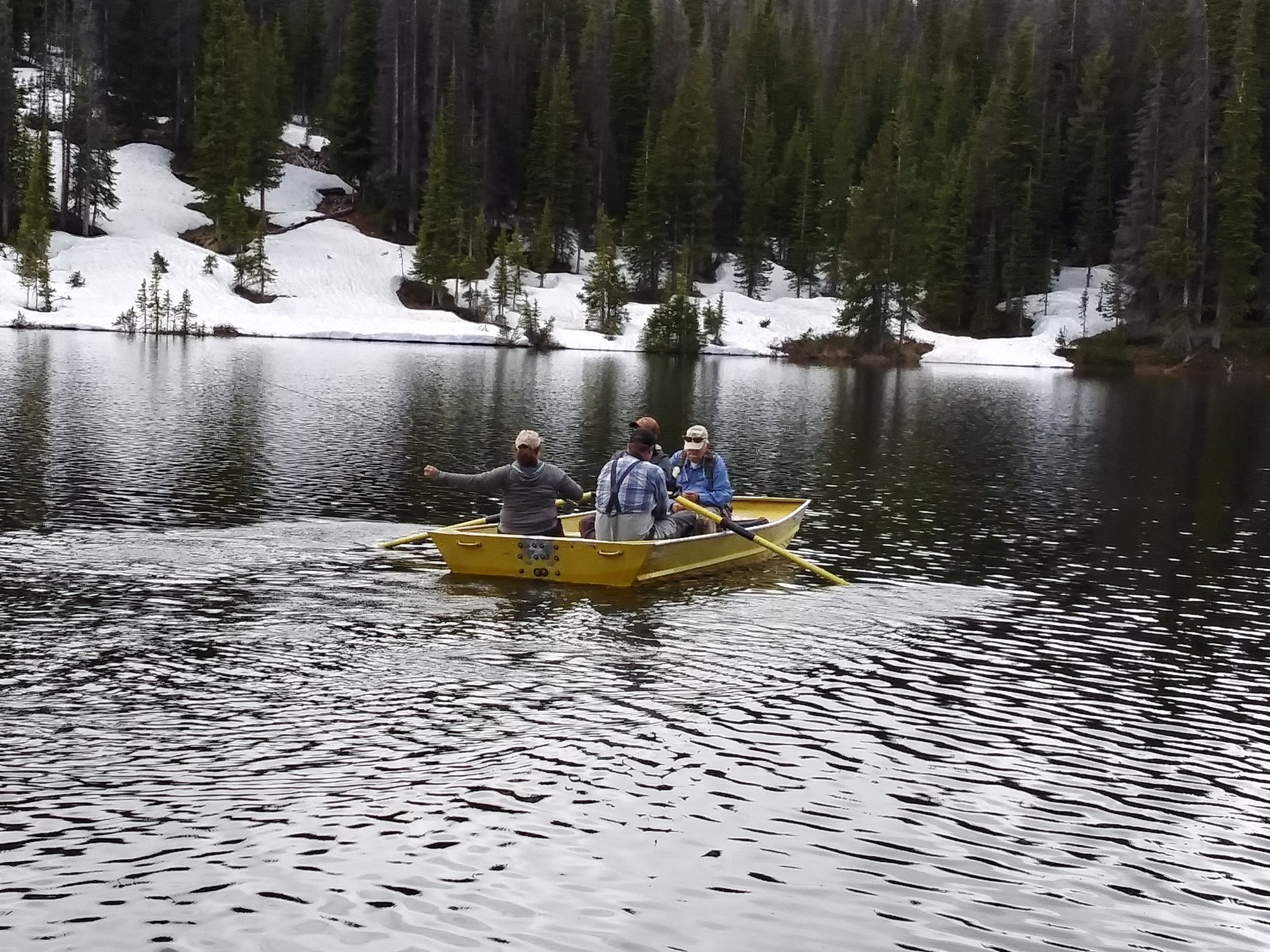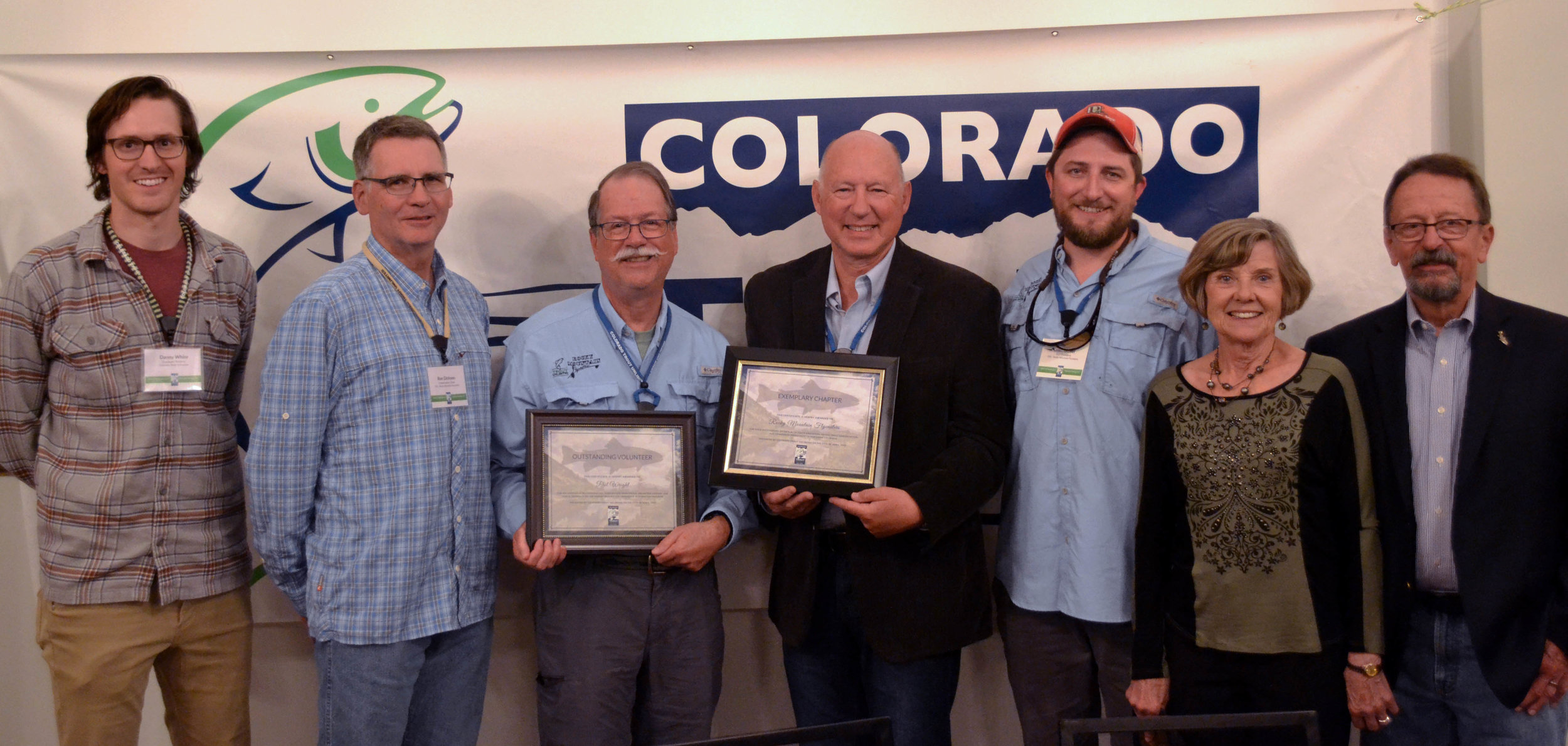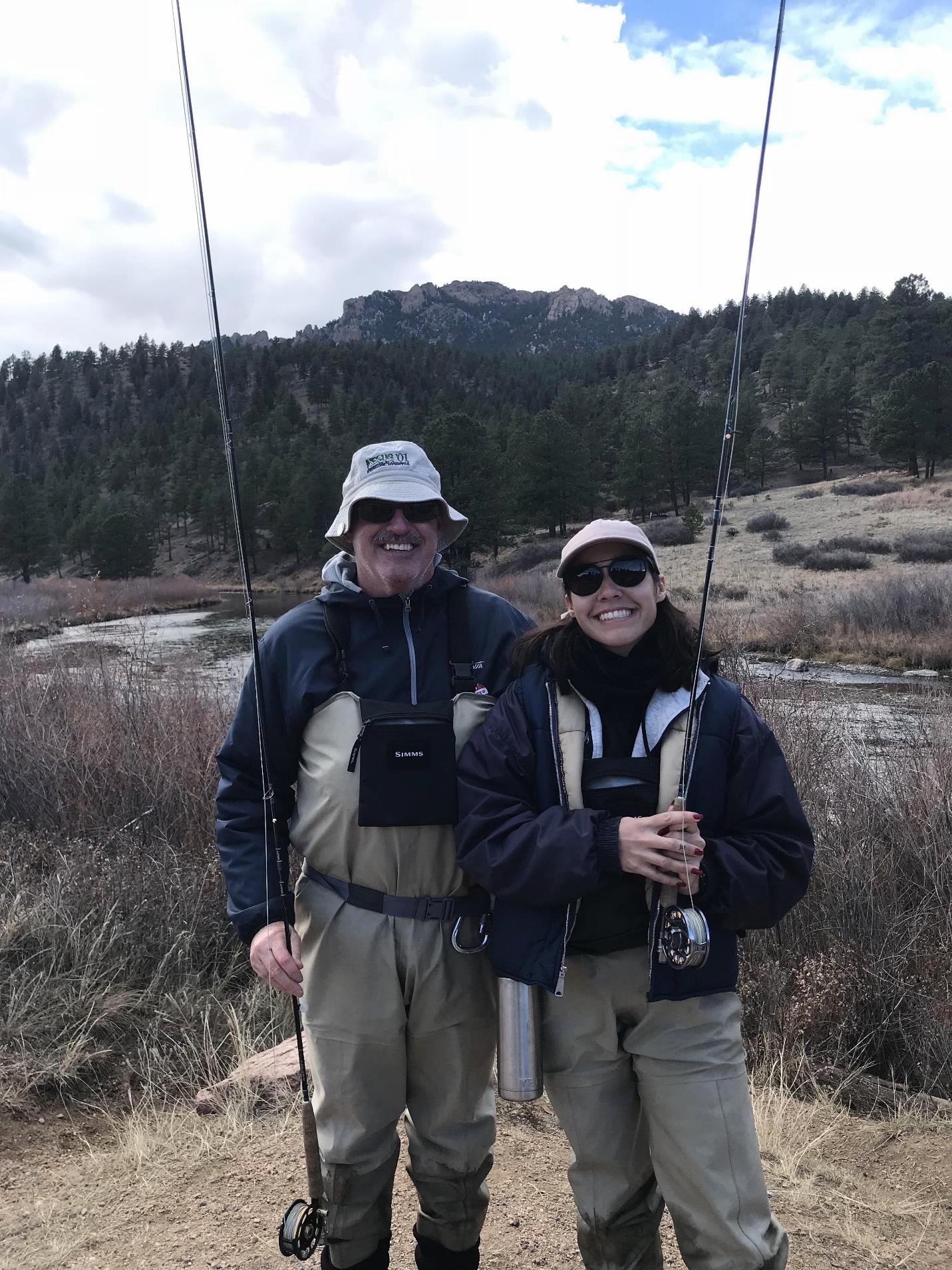We’re excited to bring you a new report looking back at another great year! Thank you taking the time to see what we have accomplished and are looking forward to.
Rise to the Future Awards - Durango TU Chapter Recognized
During a virtual ceremony on May 26, Forest Service Chief Vicki Christiansen and Acting Deputy Chief Tina Terrell announced the 14 employees and partners who are recipients of the 2020 Rise to the Future awards. The awards, created more than 30 years ago, recognizes leadership in stewardship of fisheries, soil, water and air resources on national forests and grasslands. In recent years, the Jack Adams and Lloyd Switch Sr. awards were added to distinguish excellence in wildlife program management.
The winners showcase a wide variety of work on and behalf of national forests and grasslands.
“2020 was a very challenging year. First, a pandemic that changed how we get our work done. A historic fire season in the west and a series of devastating storms in the south,” said Chief Christiansen. “I continue to be amazed at the resilience and perseverance of our employees and partners to face the challenges that come our way.”
Among the many recognized, our partners at the Forest Service, as well as the Five Rivers Trout Unlimited Chapter out of Durango, CO were recognized with the Collaborative/Integrated Aquatic Stewardship Award for their work on the Himes Creek Instream Flow Project.
The Himes Creek Instream Flow Project Team on the San Juan National Forest in Colorado collaborated to achieve critical aquatic habitat protection for a trout once thought to be extinct. Working within the confines of Colorado State Law, the team’s integrated efforts secured instream water flow to protect trout habitat on lands managed by the Forest Service, an accomplishment recognized by the Governor of Colorado. These protections would not be in place without the strong collaboration of partnership. The team includes representatives from the following organizations:
Forest Service: Andrea Rogers, Polly Hayes, Bill Janowsky, Kelly Palmer and Kara Chadwick
Colorado Water Conservation Board: Linda Bassi
Trout Unlimited: Buck Skillen
Colorado Parks and Wildlife: James White
Another award went to one of Colorado’s regional office’s for the Friend of the Fish/Watershed Award going to Doug Wise and the Engineering staff at the Rocky Mountain Regional Office, who are cited for their work using the Great American Outdoors Act to establish a project evaluation team, bringing together multiple resource leads to prioritize projects. The engineering staff has been instrumental in facilitating 15 aquatic organism passage projects in the region, working to address deferred maintenance of the region’s infrastructure. The collaboration between fisheries, engineering, and other programs within the agency provided the region with an integrated and productive team leading the way to complete many beneficial and crucial projects. These projects improved recreational fishing access across the region and opened new opportunities to work with external partners, engage local students, and continue to improve fish habitat on the forests.
Congratulations to the Colorado winners, it is much deserved for all the hard work you do in our state!
Profiles in Conservation
Duranglers Flies and Supplies: Supporting Conservation and the Fly-fishing Community for 36+ years.
In February of 1984, the Five Rivers Chapter of Trout Unlimited, led by Neill Peterson, John Flick and David Wilson, was certified as Chapter number 451 of Trout Unlimited. Among the founding members were Flick, Jim Herrig, Byron Hilliard and Tom Knopick.
The chapter was established only a couple of months after the founding of Duranglers Flies and Supplies by Flick and Knopick. John and Tom both recognized the intrinsic relationship between the business they planned to grow and the need for active conservation of the incredible cold-water fisheries to which they called home.
Pictured: Tom Knopick
This commitment by John and Tom and Duranglers has been carried forward, often with fierce dedication, to our present time and will carry on for the future. But, let’s go back and remember some of the past conservation efforts that Duranglers has helped advance.
Hermosa Creek, which is currently undergoing reintroduction of native Cutthroat to 23+ miles of East Fork and Mainstem, was an early focus of habitat improvement by Five Rivers TU and John, Tom and Jim Herrig. Most of this work was done on the reach above Hotel Draw. In addition, log structures were introduced on the East Fork for habitat development in the area of Hermosa Park.
The headwaters of the East Fork of Lime Creek also benefitted from habitat improvement undertaken by the Chapter.
Pictured: John Flick
One of the Rivers precious to John and Tom is the Dolores River below McPhee Reservoir, locally known as the “Lower D”. This tail water was created in 1984 when the Dam was completed. The result was a fabulous cold-water fishery that was stocked with Snake River Cutthroat Trout as well as rainbows and browns. The combination of (formerly) abundant cold water and great water quality allowed the bug life and fish to thrive. It was not uncommon to catch trout upward of 20” and 4 – 5 lbs. Needless to say this was the subject of many guided trips by Duranglers, video programs such as the Fishing The West TV show with Larry Shoenborn Guided by Tom Knopick and relentless attention to the conservation of the resource by the crew at Duranglers.
Then in 1990 the area began to endure a series of drier years. When McPhee was created an Environmental Assessment was undertaken, one of the first such assessments in the West. While the EAS called for releases of 70, 58 or 20 cfs, depending on the reservoir level to maintain the quality of the coldwater fishery, the fishing community felt these flows to be inadequate. This became abundantly clear when in just a few short years of 20 cfs releases most of the fish, particularly the healthy adults, died due to low water and heat stress. The golden age of the “Lower D” came to an end.
But not without Tom and John, personally leading the push for more water for the fishery. In subsequent years, they have been at the forefront of efforts to find water for the fishery and have been partners with Colorado Parks and Wildlife in helping to establish greater release of water for the fishery.
In the early 1990’s, Chapter leadership was taken over by Jay Engel and others. Jay had been a leader in the fly fishing community for years on the West Coast and was a tireless advocate for cold-water conservation, eventually being recognized with the Silver Trout Award. In the middle 90’s Jay passed away unexpectedly and was soon followed by the Chapter’s Treasurer. This left the Chapter leaderless and it went dormant for a couple of years.
In Spring 1999 a group from Duranglers led by John, Tom and Nate Bronson gathered a group together in the upstairs of Gazpachos, a local New Mexican restaurant, with the intent of reviving the Five Rivers Chapter. And, resurrect it they did, with John and Tom helping behind the scenes with fund raising and tolerating the occasional minor disruption from one of their part time employees, who had assumed the reins of the Chapter.
To this day in 2020, we owe a tremendous debt of gratitude to John and Tom for their support and dedication to conservation of our cold-water fisheries, particularly in southwest Colorado. This was evident in 2018 when CTU recognized Duranglers Flies and Supplies as Outfitter of the Year at its Rendezvous in Glenwood Springs, just one year after recognizing the Five Rivers Chapter they helped establish and revive as Exemplary Chapter in 2017.
So let us raise a glass of whatever beverage is preferred and toast Duranglers and John and Tom for their past and future support of all of TU’s conservation efforts. To check in on what is happening fishing wise in Southwest Colorado or to just say hi you can reach them and Duranglers Flies and Supplies at 970-385-4081 or www.duranglers.com.
Tight Lines,
Buck Skillen, Past President, Five Rivers Chapter TU
Profiles in Conservation is a new blog series sharing the stories of important long-term leaders in Colorado’s fly fishing and conservation community. If you would like to share a story or nominate a flyfishing leader for this series, please contact us at info@coloradotu.org.
Behind the Fin with Sinjin and Rick
Rick Matsumoto and Sinjin Eberle. This was taken at Rendezvous 2013 when Sinjin officially turned over the presidency to Rick.
Editor’s Note: Somewhat embarrassingly, we’ve managed to produce over 30 BTF posts without interviewing Sinjin Eberle or Rick Matsumoto. They were back-to-back Presidents of Colorado TU from 2010 to 2015. The organization was highly effective during this timespan in part because they led Colorado TU as a team. We’re making it up to Sinjin and Rick with this special edition of Behind The Fin in which we talk to both at the same time and learn about what made them such a good team.
BTF: Let’s start by getting some of the basics out of the way. You guys were good friends before you became involved with TU, but bonded over river conservation, right? Tell me about how you first got involved with Colorado TU.
Sinjin: That’s right, we met playing volleyball at the Denver Athletic Club and got to be good friends playing local tournaments. But I had been on CTU’s board at least a few years before that. I was recruited by Sharon Lance at a Denver TU meeting. I think she was the council VP at the time.
Rick: We bonded more because of our competitive spirit than river conservation. I’m probably not supposed to say that in an interview for CTU, but it’s true. We pushed each other to compete, and had a great time doing it. River conservation came later. I think I was just coming off a long volunteer stint with the Alumni Association of the University of Michigan.
Sinjin: Oh, here it comes. Rick: Go Blue!
Sinjin: And there it is.
Rick: He’s jealous. Anyway, I was looking for another volunteer opportunity. It just happened to be right about the time Sinjin was getting started with the Buffalo Peaks project.
Sinjin led the Buffalo Peaks Ranch Restoration Project, restoring a key section of the Middle Fork of the South Platte River in 2008. This picture, taken in August 2019, shows how beautifully the area has matured since the restoration. It provides some of the best publicly-accessible fishing in South Park.
BTF: At the time, the Buffalo Peaks Ranch Restoration Project was the largest restoration project CTU had ever done. How did you decide to take on such a large project?
Sinjin: Certainly, the bigger the project the greater the risk. But the board is pretty good about evaluating projects, both in terms of conservation value and financial risk. As I recall, our confidence was high because of the parties involved - the Colorado Division of Wildlife, City of Aurora, Park County, and a private landowner. And I wanted to take it on because it was ambitious. If I’m going to volunteer my time, pull in others like Rick to volunteer their time, then let’s make sure it’s for a good reason. Let’s work on the things that are the most impactful.
Rick: There’s that competitive spirit I was talking about. As a first-time volunteer, I really appreciated that I was working on something that made a tangible difference. Too often, volunteers are tasked with bringing food or producing a newsletter or washing cars. Don’t get me wrong, it all has to be done, but I really enjoyed being outdoors, busting my ass, working with others who felt the same way, on a section of river I could visit for years to come.
BTF: So that’s what prompted you to join the CTU board?
Rick: Not exactly. I think I could have worked on CTU projects without joining the board and been content. The late Charlie Meyers, whom I first met at Buffalo Peaks, inspired me to make a difference. But Sinjin gets most of the credit, or blame depending on who you ask. I still remember a night at Sinjin’s house with Tom Jones…
Sinjin: Tom was the National Leadership Council Rep at the time, and a board member that I viewed as a trusted mentor. Many think of these years as the “Sinjin and Rick” years, but Tom was the NLC Rep for both of us. He was really the voice of reason that kept us in line.
Rick: Most of the time. We probably should have asked him about that video we posted of a bulldozer in the river.
Sinjin: Yeah, he wouldn’t have approved.
Rick: We were sitting at Sinjin’s dining table. I think Tom was drinking whiskey and I was drinking scotch. I’m not sure what Sinjin had, a Moscow Mule?
Sinjin: Sounds about right.
Rick: We talked for hours about Sinjin’s upcoming term as President. It was generally about how Sinjin felt we could bring a different approach with a different energy. I remember leaving his house thinking about his vision, how I as VP was going to help, how great it was to be able to lean on Tom for advice. Honestly, I didn’t know much about David Nickum or the other board members or the history of the organization, but I was pretty sure we were going to kick ass!
Sinjin: That was really the starting point of our next five years. Nobody explicitly said “this is our five year plan,” but we were all on the same page about how we wanted to operate and so we never thought twice about projects that might take several years to complete.
BTF: Give me an example of one of those longer projects.
Sinjin: The Roan Plateau is what first comes to mind. I only had a small part in getting it done, Nickum and Ken Neubecker deserve most of the credit, but our persistence in protecting the Roan Plateau is the thing I think about with the most pride. Especially now, when oil and gas issues are overwhelming our public lands, our work to protect that little slice of wildness is really satisfying. It took nearly a decade for all of the litigation to play out. Grand Valley Anglers was fighting oil and gas leases on the Roan before I became President and the final settlement happened after Rick was done being President, but we had several milestone victories in between because of CTU’s strong and consistent voice during both our terms.
Rick: Absolutely. The other project that comes to mind for me is the Protect Our Rivers license plate. The board didn’t even want to take it on because it had been tried before and failed. I thought, “fine, then you can watch while I do it.”
Sinjin: I had your back.
Rick: Totally. And so I did the research, got Nick at Sage Lion Media to design the plate, created the petition, got the signatures, we drafted the bill. I remember Jen [Boulton, Legislative Liaison for CTU] saying it was looking good, and then it just blew up in our faces. For some reason, the chair of the House Ag Committee shot the bill down. That was the legislative session of 2011.
Sinjin: You’re just pointing out it failed during my presidency.
Rick: Well, it did! It was really disappointing, but then the political landscape changed and we did it all over again with SB13-224. I still remember the bill number! It succeeded, during my presidency of course, but only because Sinjin had my back two years earlier. The plate went into production in 2014 and we just recently passed 3,000 plates sold. My wife and I still point out the plates and smile when we see them on the road.
Rick led the initiative to establish the Protect Our Rivers license plate. Over 3,000 have been purchased since the plate first went into production in 2014, making it a permanent offering in Colorado.
Sinjin: Rick hates to lose and in this case it drove him to persevere. I knew he would get it done. Tom and I used to call him the “hit man” because we knew we could give him an assignment and send him on his way. We didn’t have to tell him how to do anything, it would just get done.
Rick: I prefer “ninja.”
BTF: I’m seeing why you two worked so well together. Would you say these bigger, longer projects really defined your presidencies?
Sinjin: Maybe in the big picture that’s true. CTU is celebrating its 50th anniversary this year, so it’s natural to look back and highlight the major achievements. But there were major achievements in every presidency, not just mine or Rick’s.
Rick: Right, I think if we’re talking about Sinjin and me together, and I’d include Tom as the mentor for both of us, we’d rather be known as the people that made some fundamental changes in the way CTU operated, and that those changes facilitated a lot of positive things happening during our five years. Some of those things were the Roan settlement and the license plate, but there were plenty of other things too.
Tom, Sinjin, and Rick at Colorado TU’s 50th Anniversary Celebration. Governor Polis kicked off the event by declaring October 15, 2019 Colorado Trout Unlimited Day.
Sinjin: Agreed. There were actually several minor victories on the Roan before the final settlement, we did the “Don’t Suck” campaign for the Upper Colorado, we created a new chapter in the Dolores River Anglers, we led the collaborative effort with Sportsmen’s Conservation and Western Water Project to hire a fundraising director...
Rick: Without the “One TU” meetings, which you created, the fundraising director would not have happened.
Sinjin: And with that fundraising director, Chris Herrman, we introduced the River Stewardship Council and made that a huge financial success.
BTF: You were both founding donors, right? And I see you are both Life Members of TU.
Sinjin: Yes, with Michael McGoldrick, Jay Boak, a few others. It was important for us to lead by example and we were fortunate enough to have the personal financial means.
Rick: Don’t forget 1% for Rivers. You got that deal done with Henry Wood at Upslope Brewing. I love seeing that logo on their Craft Lager label.
Sinjin: And you turned it into a larger corporate sponsorship program that pulled in many others, even that car wash in Highlands Ranch!
Rick: You also deserve credit for bringing the Greenbacks into the fold. You managed Nick Hoover through some rough waters, but it was an innovative approach that got a lot of attention at National TU.
Sinjin: That, I think, we can take credit for as something that was far more likely to happen with you or me at the helm. I mean the whole reason the Greenbacks came to be in the first place was because a younger, more hip group of conservation-minded people felt like TU was becoming an “old, white man’s fishing club.” We at least didn’t look like the part.
BTF: Okay, so those are all things you achieved during your presidencies…
Sinjin: Things that the organization achieved while we were presidents - I think it’s important to recognize how everyone was rowing together.
BTF: Right, but with you sitting at the front of the boat. I wanted to ask about something you said earlier, Rick, about changing the way the organization operated.
Rick: I’ve had a long career in operations, so I naturally see ways to make things more efficient or effective, sometimes both. Sinjin and I spent a lot of time in cars, driving to and from chapter and council meetings, talking about ways to do things better. For example, we made an effort to apply Robert’s Rules of Order to board meetings. Honestly, we didn’t like some of the formalities, but we needed a way to streamline the board’s tendency to have lengthy discussions that didn’t drive toward decisions. It didn’t really make the meetings any shorter, but it did make them more productive.
Sinjin: I remember now one of the first things Rick did was take control of Rendezvous. He put together a planning committee and ran weekly meetings to keep people on task. He lined up strong speakers and forced them to deliver presentations in advance, produced a slick binder and name tags, held all of us to a schedule that included time for socializing. It totally rejuvenated Rendezvous. In fact, several National TU staff made a point of attending the following year and they weren’t shy about saying it was the best council event in the country.
Rick: The planning committee gets the credit and you’re the one who got sponsors to pay for the binders and name tags. But yes, I’m proud to have created a stronger process that CTU was able to carry forward even after our presidencies were done. Sinjin did a lot of this type of fundraising work, where I think I did more in the area of non-profit governance. When you put it all together, I think it meant the business side of CTU ran a little more smoothly.
Sinjin: And when you’re confident that the business side is humming along, it allows you to flex your muscles on the conservation side. CTU has always had a great deal of conservation-related expertise and passion in its board. That expertise and passion just comes through stronger when the organization is operating efficiently.
BTF: Since this is a Behind the Fin interview, I’d be remiss if I didn’t ask for a fishing story or two.
Sinjin: Superfly!
Rick: Yeah, we competed in a few Superfly tournaments.
Rick and Sinjin working the Gunnison River in the 2010 Superfly tournament.
Sinjin: Rick was so mad one year he didn’t say a word to me the entire drive back!
Rick: That was the day I decided to dramatically raise my fishing game. And I did get a lot better, and it showed in the next Superfly.
BTF: But you didn’t win?
Sinjin: Nope, I think I was the weak link that year, but Superfly is mostly about drawing the right beats. Skill plays a role too, but there was one year where everybody on the Taylor River did dramatically better than everyone else.
Rick: Speaking of the Taylor…
Sinjin: Oh yeah. We stopped at the “Hog Farm” one time, that stretch of the Taylor just below the dam. Rick hooked the hog of all hogs, got it to shore, but … it made a last ditch run and got away before I could net it.
Rick: He’s leaving out the part where he snapped my tippet with his net. It looked like he was trying to club the fish rather than land it. Complete spaz, I will never forgive him for that one.
BTF: Okay, we’re in the home stretch now. Sinjin, I wanted to hear a little bit about your work at American Rivers. It’s obviously very relevant to our work at Colorado TU and I think it gives you some interesting perspective.
Sinjin: Well, I’m the Communications Director for the Colorado Basin, handling all of our marketing, communications, and outreach. Mostly, I work with a trio of conservation campaigns: the Colorado Water Plan, the Arizona Water Sustainability campaign, and the Upper Basin Demand Management program. I also run American Rivers’ Grand Canyon campaign, which was instrumental in stopping the plan to build an aerial tramway into the heart of the canyon and limiting the expansion of the town of Tusayan.
BTF: Great, it sounds like there are similarities with the types of things CTU would be involved in. Is that what attracted you to American Rivers, just doing it for a larger geography?
Sinjin: Sure, but CTU is a much stronger grassroots organization where American Rivers is more communications- and policy-oriented. It’s that emphasis on communications that prompted me to get into filmmaking. Over the past four years, I’ve created, directed, or produced over a dozen short films. I’m having a great time making character-driven films that deliver a powerful message about river conservation. The Important Places, won several awards and generated over a million online views, so I have a lot of freedom and support to do more of this kind of work.
Rick: I think it’s super smart. I mean, the movie was great, but I’m referring to the strategy of telling these stories about people who are impacted by conservation issues without even using the “conservation” word.
BTF: That sounds controversial, almost counter intuitive.
Sinjin: I hate to say it, but films about conservation just aren’t as interesting as films about people. My latest film, Sonora Rising, is about the circular economy of water, through wheat, flour, and bread in Tucson, Arizona. The idea is to broaden our reach by making something good enough to get into film festivals. Shoot, if you get into the Wild and Scenic Film Festival, the winning films are shown on a 175-city tour. And that’s in addition to online views through YouTube and Vimeo. We’re getting a strong conservation message out to a lot of people. It’s very, very satisfying work.
Rick: And there’s that competitive spirit again. There’s no shame in pushing yourself and those around to do excellent work out of a desire to make something better. Winning film awards or council awards - Colorado TU won the State Council Award for Excellence in 2014 I think - is great, but it’s a byproduct of just consistently working hard to get better.
BTF: Good segue back to TU. One of the questions we like to ask, and this really is the last question for each of you, what advice would you have for current TU members?
Rick and Sinjin, attending the Silver Trout Award presentation at Rendezvous 2017. This distinguished award is given to individuals whose conservation work for Colorado Rivers has made a significant and lasting impact. Both are Silver Trout Award Winners.
Sinjin: My advice is to go all in, and commit to something bigger than yourself. What do you have to lose? It’s so easy to be complacent about and intimidated by the giant array of challenges facing our environment, to just throw up your hands in defeat. But the joy and inspiration the outdoors provides is worth putting forth our best efforts. Even with a small commitment of effort, we can have a real impact. Money and fame and more fly rods are all nice, but the satisfaction of knowing that you were part of protecting a place, or even better, inspiring others to give back to the landscapes we care about is like a multiplier effect for the world. Activism doesn’t have to be some dopey, granola-crunching, tree-hugger aspiration – our rivers and streams, and by extension our public lands, need our voices or they are going to be gone. What better place to spend your hard-earned time and efforts than that? Do something. Write your representative. Lean in to make change happen.
BTF: That’s tough to follow, but same question for you Rick.
Rick: Ha, it’s okay, those are the same inspiring words that brought me to Colorado TU a decade ago. Like Sinjin, I believe in “committing and going all in,” but there’s a big difference between joining the board of Colorado TU and going to a river clean-up event. I would tell members to take the initiative to be responsible for their own level of involvement. Don’t wait for someone to give you a menu of volunteer options. Go talk to other members, reach out to staff, ask chapter or council officers what they need help with. Find what’s right for you. Then commit and go all in! That’s how you control your effort, make sure you have a rewarding experience. I think Sinjin and I did an honest job of that when we first got involved. It really helped us get the most out of our time on the board, and give our best to the organization.
BTF: Great answers guys, and it’s been really fun talking with you. Thank you for taking the time to make this a truly special edition of Behind the Fin!
CTU 50th Anniversary Film headed to Zimmerman Lake this summer (Behind the Scenes)
On July 2, 2019 passionate TU volunteer and native trout angler, John Trammell headed up with CTU and Josh Duplechian of Trout Unlimited to participate in filming for CTU’s 50th Anniversary Film featuring the native trout work on Zimmerman Lake. Below is his personal account of the day. Enjoy!
John and his daughter Melissa.
MY LIFE AS A FLY FISHERMAN PART 21: Greenbacks and Zimmerman Lake
by John Trammell
Up front I’ll confess that not much of Part 21 is about fishing, but about what I observed at Zimmerman Lake on July 2 this year. What I saw was a team of government agencies and Trout Unlimited volunteers working scientifically and physically to preserve and propagate our state fish - the greenback cutthroat trout. I could not have been more impressed by the skills and hard work I saw. Really amazing.
Zimmerman lake is 40 miles east of Walden, near the continental divide, at 10,000+ feet elevation. It has a population of a few hundred greenbacks, placed there to become the source of eggs for the purpose of increasing the numbers of our state fish. On the day my daughter Melissa and I were there, the steep trail up to the lake was both rough and muddy, with numerous snowdrifts. (The day before, the workers had shoveled away drifts that were impassable to ATVs.)
The ancestors of the greenbacks in Zimmerman Lake were a small number of fish rescued from their only remaining natural habitat, Bear Creek near Colorado Springs, when the habitat was threatened by a wildfire. Being so few, when they’re artificially spawned it is important to preserve genetic diversity. Observing how that is done was fascinating - not only because of what was done, but how it was done under difficult field conditions.
When we arrived at the work site the fish were already being held in floating mesh pens. Wader-clad workers separated them into categories to be processed on a long table set up amid mud, snow and trippy exposed tree roots. They were given an anesthetic bath to make them more docile and to reduce shock while they were being processed.
CPW’s project leader Kevin Rogers told me that his agency knows each greenback in the lake individually. Each has a little VIE tag behind its eye that he identifies to a person who then uses a hand-held electronic device to read an internal pittag. Each fish is described verbally (e.g, “ripe female, good condition; immature male”), its pittag recorded, measured, weighed, and photographed beside its PIT number. Then the fish is put into a five-gallon bucket of water, to recover from the anesthetic. This all occurs rapidly as the trout are passed down the table. This information is used to select males and females to have their eggs and milt combined. Records of the combinations are kept with the intent to achieve maximum genetic diversity.
After the anesthetic has worn off and the greenbacks are trying to swim out of the buckets, they are returned to the lake. Forest Ranger Chris Carrell hustled those 40-pound buckets down to the lake all afternoon, quickly returning the empties back to the table for more greenbacks. After a while, realizing the physical toll it was taking on him, Melissa helped. Although she wasn’t there as a representative of her agency, the National Park Service, she also helped with the work at the table. Being somewhat enfeebled by the trip up to the lake, I just sat, and observed.
Fertilized eggs are treated with an iodine solution, and taken to CPW’s Mt. Shavano hatchery to be hatched and reared for stocking into suitable waters. In addition to the objective of saving them from extinction, the aim is to have a sustainable population of greenbacks for Coloradoans to enjoy.
I’ve long been a fan of native cutthroat trout, so I’m grateful to the State of Colorado for going to the expense and trouble to save the greenbacks. And I’m grateful to the agency people and TU volunteers who do the work.
““I know I volunteer because I love trout, trout habitat, and trout fishing. Of those three, I think it’s the habitat I love best, and not just because without it we can’t have the other two. It’s because I just love it, everything about it. I get a thrill every time I approach a trout stream.””
2019 Summer Youth Camp Video features youth learning about rivers and fly fishing
Greenback and CTU volunteer, Emma Brown, put together a great feature about the 2019 CTU River Conservation and Fly Fishing Youth Camp in Almont, CO. Check out the great video she filmed above!
The River Conservation and Fly Fishing Camp is a week long camp designed to educate 14 to 18 year old students on the importance of cold water conservation and provide hands-on fly fishing instruction. Approximately 20 students are selected each year based on their qualifications and a written essay on why they would like to attend the camp.
Camp classes include: Principles of Ecology, Hydrogeology, Aquatic Vertebrate and Invertebrate Sampling, Hydrology, Trout Behavior, Trout Stream Entomology, The Biology of Pollution, Acid Deposition, and Politics of Conservation and Human Effects on the Rocky Mountain.
In addition, the camp will include hands-on instruction on Fly Tying, Fly Casting, Stream-side Ethics, Angling Literature, Stream-side Botany, Wader Safety and Survival, and The Evolution of an
Angler. The campers will also participate in a watershed project to repair habitat in a nearby stream.
CTU Recognizes Outstanding Contributions to Trout Conservation
Pictured: Awardee Kevin Rogers, Colorado Parks and Wildlife biologist and researcher.
At the annual Rendezvous at the Hotel Colorado in Glenwood Springs, Colorado TU presented its annual awards recognizing volunteers, chapters, and partners who have made exemplary contributions to TU and trout conservation in Colorado.
Colorado Parks and Wildlife biologist and researcher Kevin Rogers received the Trout Conservation Award. Kevin is a long-time native species researcher and has been an instrumental part of native cutthroat trout restoration efforts and developing and understanding the underlying science – including the new insights that have been gained about the different genetic lineages of cutthroat that guide restoration efforts statewide now. For years, Kevin has provided the scientific and moral leadership that guides cutthroat conservation and recovery statewide.
Black Canyon Anglers were honored as the Exemplary Guide & Outfitter for 2019. Black Canyon Anglers has been a long-time financial support of Trout Unlimited’s conservation efforts, including multiple years of providing a statewide raffle prize that has generated tens of thousands of dollars in proceeds. Additionally they have been active participants and provided logistical support for conservation efforts in the Gunnison Gorge including programs to help re-establish rainbow trout populations in the face of whirling disease.
Anglers All being presented with the Exemplary Industry Partner award from CTU.
Anglers All was recognized as the Exemplary Industry Partner. Through direct support and special events including their annual Trout Clave, Anglers All has generated thousands of dollars to support trout conservation in Colorado. Additionally they have been active partners on restoration and river cleanup efforts along the Denver South Platte.
Colorado TU presented two Distinguished Service Awards this year. The first went to volunteer leader Peter King with the Cutthroat Chapter for his successful efforts to link Trout Unlimited with new corporate funding partners, opening doors for support for youth education efforts from notable companies including Anadarko Petroleum and Conoco Phillips. The second went to Patrick, Miller and Noto LLC, a Carbondale based law firm that provided pro bono legal assistance to Colorado TU and American Rivers in the successful effort to eliminate the threat of Aspen-owned dams being build on Maroon and Castle Creeks including in the Snowmass-Maroon Bells Wilderness.
Rocky Mountain Flycasters Chapter received the Exemplary Chapter award (middle right) as well as the Outstanding Volunteer award going to member Phil Wright. (middle left)
The Rocky Mountain Flycasters Chapter (Ft Collins/Loveland/Greeley) was recognized as this year’s Exemplary Chapter. The Chapter was recognized for its strong community engagement programs around the Cache la Poudre River, its leadership with the ambitious Poudre Headwaters Restoration Project to restore greenback cutthroat trout through nearly 40 miles of headwater streams, and its strong youth education efforts including an annual youth day camp.
The Exemplary Youth Education Award was presented to the Collegiate Peaks Anglers for their partnership with the Greater Arkansas River Nature Center on the new South
Arkansas Ecological Learning Center and their model “Stream Explorers” program for youth education in the Salida area.
The John Connolly Outstanding Chapter Communications Award was presented to the Five Rivers Chapter. The chapter was recognized for its newly revamped website, social media, and email communication efforts including partnership efforts with local fly fishing and women’s groups to help broaden their reach in the Durango community.
Two chapters were recognized with the Exemplary Project Award. First, the Gunnison Angling Society was honored for its Adopt-a-Trout project, which combined STEM-based youth education while providing data that helped establish the foundation for new water leasing programs with agricultural producers in the valley and helped build stronger relationships among diverse local partners. Additionally, the Denver Chapter was honored for its “Long Underwater Non-Kinetic Embankment Replacement” structures (“LUNKER” structures) that provide shelter for aquatic life from current and predation, mimicking the natural habitat of an undercut bank in the highly modified Denver South Platte where natural undercut banks no longer exist.
Taila Oulton receiving an Outstanding Volunteer award for her work with the Colorado TU Youth Camp.
Finally, Colorado TU recognized five Outstanding Volunteers from various chapters across the state. Keith Krebs was recognized for his work with the Collegiate Peaks chapter in advancing the Ecological Learning Center as well as overall chapter leadership. Taila Oulton was honored for her seven years of participation as a counselor with the Colorado TU Youth Camp – as a former camper and young adult, Taila has not only shared her significant fly fishing knowledge but been a relatable role model for younger campers. Barbara Plake was honored for her work in launching and growing the Collegiate Peaks chapter’s “Fly Gals” program from 5 to more than 100 participants as well as managing the chapter scholarship program and Caddis Festival banquet. Dan Sullivan was recognized for leadership with the West Denver Chapter and in particular for his work in improving chapter communications and helping to expand participation in chapter events and volunteer projects. Phil Wright from the Rocky Mountain Flycasters Chapter was recognized for his work with native trout conservation efforts in the Poudre watershed including stream temperature monitoring of potential recovery habitats, assisting agency biologists with field work in preparation for restoration the Poudre headwaters, and developing community outreach efforts around the recovery project.
A hearty congratulations to all of our 2019 award winners – with deep thanks for all they have done to benefit Trout Unlimited and coldwater conservation.
A Legend Passes
Last night, long-time TU leader Fred Rasmussen passed away at his home in Salida at age 95. His ready smile, always offering a hug and a kind word, and his trademark white ponytail made him a readily recognizable figure within and beyond TU for many years. His lifetime of service made him a role model that those of us following in his footsteps can strive for even as we inevitably fall short.
While always modest about his service (“We were a bunch of scared kids just doing what we were told to do”) , Fred was a part of the “Greatest Generation” that helped America and our allies face down fascism during World War II. His hometown newspaper, The Mountain Mail, ran a story about his war experiences that you can read here.
Following the war, he went onto a distinguished career developing science curricula and co-authoring textbooks. He lent those talents to Trout Unlimited and his community, helping to develop the hands-on inquiry-based “Stream Explorers” curriculum that continues to be used for youth education activities with the Collegiate Peaks Chapter in his hometown and with others around Colorado.
Fred’s service to conservation and Trout Unlimited is extensive - from serving with his local chapter, to chairing Colorado Trout Unlimited, to serving on the National Trout Unlimited Board of Trustees and with his fingerprints on activities from his local chapter banquet, to on-the-ground restoration projects in South Park and the Arkansas basin, to leadership on vital issues like the fights against Two Forks and whirling disease. Perhaps his greatest mark, though, was with the many other TU leaders that he helped mentor over the years who were able to carry his example forward in their own efforts. He helped all of us keep sight of the fact that Trout Unlimited’s mission was coldwater conservation - and that if we didn’t rise to that challenge, who would? His commitment and leadership were recognized nationwide, as Fred was honored with lifetime achievement awards from Colorado TU (the Hoagland Award), the Silver Trout Foundation (Silver Trout Award), and National TU (the Mortensen Award).
As a soldier, educator, volunteer, leader, parent and grandparent, Fred left an indelible mark. To me, he will always personify that “Greatest Generation” not simply because of his distinguished war service, but for the legacy he built over the rich lifetime of service that followed. May his example continue to inspire all of us, and may he rest in well-earned peace.
David Nickum, Executive Director of Colorado Trout Unlimited
Jon Rasmussen shared the following as Fred was moving into hospice care at his home:
Fred is close to passing. He is comfortable, not in pain and surrounded by loving family. Thank you ( and all of his TU friends) for being such a fulfilling part of his life.
It will be hard to lose my best friend & fishing buddy. But, Fred has helped lay the ground work for this joy to extend long into the future for my sons & I.
Behind the Fin with Cooper Hyland
Cooper loves helping others catch fish!
Join us Behind the Fin with 13-year-old Cooper Hyland, JR Fishing Guide and TU Member.
How long have you been a TU member?
I have been a Trout Unlimited member for about 2 years now.
Why did you become a member and what chapter are you involved with?
I became a TU member because I met the manager of our local chapter, Greg Hardy, when I was fishing and he said it was a good way to help our fish so that they could be big and strong for all fisherman.
What is your favorite activity or project you have done with TU?
My favorite project that I have done with TU is the group fly tying session it was very cool to have so many people to learn from and so many secret flies.
Do you have a favorite place to fish or fun fishing story?
My favorite fishing story is when I was teaching a kid to fish and he was getting very discouraged because he could not get any fish and the last 5 minutes we were trolling with a Rapala and a huge brown trout ate it. When we got the monster on he was on a heavy rod and he almost broke it. As we got it into the boat the fish was in the net and before we get it into the boat he spun his head and snapped the hook and got away. We had no picture of the fish. I felt so bad that we did not catch the fish, But a couple months later the mom of the kid called me to thank me for introducing him to the sport she says that he has become a self-made fisherman and is now fishing at least 1 time per week.
What does being a part of TU mean to you?
Being a TU member means a lot, but to me but I think that what it means to me the most is that I can sleep knowing that we are keeping our waterways safe and clean for future fisherman.
What other hobbies or activities do you like to do?
Some of my other hobbies include rocketry, engineering, electronics, and math.
I took my dad fishing
Happy Thanksgiving everyone! On this day we would like to share a story from one of our CTU staff about taking her dad fly fishing in Colorado. We hope everyone has a safe holiday and finds time to spend it with friends, family, or the great outdoors!
Written By Bianca Martinez-McGrath, CTU Youth Education VISTA
Bianca’s dad holding a rainbow trout before releasing back into the water.
Over the past 5 years, I have moved around to a lot of different places. It has gotten to the point where my parents are quick to ask me “where are you going next?” so they can start planning their next vacation to come see me. So, when my parents decided to come to Colorado a couple months after I first arrived, I knew I had to make this trip memorable for them. I took them to see the Garden of the Gods and to a Cuban-inspired jazz show in Downtown Denver. We went up to the Wild Animal Sanctuary in Keenesburg, Colorado and, considering my new position with Colorado Trout Unlimited, I knew it would only make sense to take my dad fly fishing.
I knew this would be a perfect opportunity for both of us because I had only been fly fishing a couple of times and my dad had been fly fishing once or twice as a child. Our guided trip with Scott Dickson of Trouts Fly Fishing shop began early with a snowy drive over to Deckers so we could fish on the South Platte. Throughout the day, we would experience just about every season of weather that exists. My goal for this trip was to learn as much as possible from Scott, see my dad catch a fish, and catch one for myself. Although I had been fly fishing a couple of times before, all I had gotten in contact with were a couple of fish that managed to unhook themselves and a few very aggressive rocks.
Bianca holding a brown trout she caught and released immediately after.
After six hours of fishing, my dad ended up being able to catch a good amount of trout. I could tell from how little quiet time there was on the way back to Denver that he enjoyed every moment of it. As for me, I caught a few Brown trout and got to see my dad fully enjoy the experience, an experience that has motivated many members of Trout Unlimited to protect and conserve their cold-water fisheries. It has been almost three years since I lived near my parents, so having this experience with my dad was an important one for me. I am only hoping that fly fishing becomes something we can do at all of the new destinations that we experience together.

